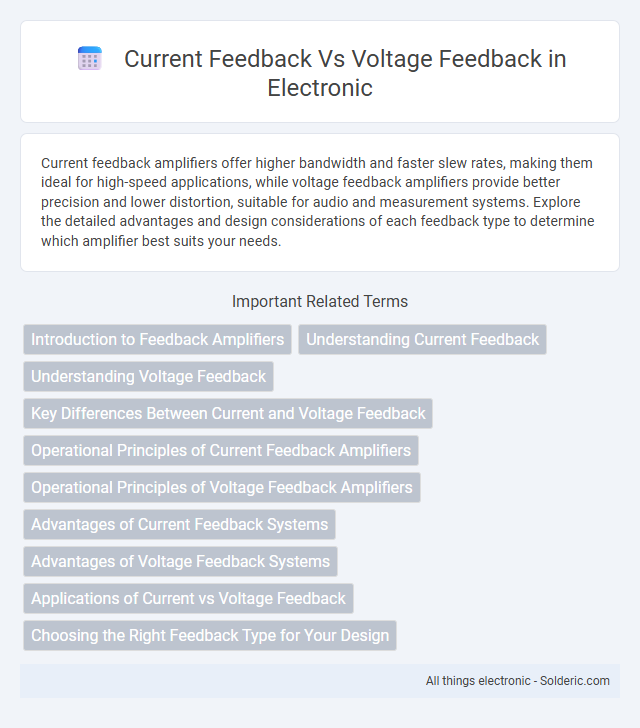Current feedback amplifiers offer higher bandwidth and faster slew rates, making them ideal for high-speed applications, while voltage feedback amplifiers provide better precision and lower distortion, suitable for audio and measurement systems. Explore the detailed advantages and design considerations of each feedback type to determine which amplifier best suits your needs.
Comparison Table
| Feature | Current Feedback Amplifier (CFA) | Voltage Feedback Amplifier (VFA) |
|---|---|---|
| Feedback Type | Current-based feedback loop | Voltage-based feedback loop |
| Bandwidth | High, almost constant over gain | Decreases with increasing gain |
| Slew Rate | Very high, suitable for fast signals | Moderate, limited by internal stages |
| Input Impedance | Low at inverting input | High at inverting input |
| Output Impedance | Moderate | Low, ideal voltage source |
| Linearity | Excellent at high frequencies | Good at low to mid frequencies |
| Noise Performance | Higher noise due to input stage | Lower noise, better precision |
| Common Applications | Video amplifiers, high-speed signal processing | Precision amplifiers, audio, general purpose |
| Input Offset Voltage | Typically higher | Typically lower |
Introduction to Feedback Amplifiers
Current feedback amplifiers use a low-impedance input to sense current and convert it to an output voltage, enabling higher slew rates and bandwidth compared to voltage feedback amplifiers, which rely on voltage sensing at high-impedance inputs. Your choice between voltage and current feedback depends on specific application requirements such as speed, stability, and distortion characteristics. Feedback amplifiers enhance gain accuracy and linearity by feeding a portion of output back to the input, optimizing performance metrics like bandwidth and transient response.
Understanding Current Feedback
Current feedback amplifiers use a feedback resistor connected to a low-impedance node, allowing faster slew rates and wider bandwidth compared to voltage feedback amplifiers. This topology improves stability and reduces distortion, making it ideal for high-speed applications such as video processing and RF communication. Your design benefits from improved transient response and linearity when choosing current feedback for demanding analog circuits.
Understanding Voltage Feedback
Voltage feedback stabilizes amplifier gain by feeding a portion of the output voltage back to the input, enhancing linearity and reducing distortion. Unlike current feedback, voltage feedback relies on high input impedance, making it ideal for precision applications where signal integrity is critical. Understanding voltage feedback allows you to optimize amplifier performance for tasks requiring accurate voltage amplification and minimal noise.
Key Differences Between Current and Voltage Feedback
Current feedback amplifiers utilize a low-impedance input stage that provides high slew rates and wide bandwidth, while voltage feedback amplifiers feature high input impedance and accurate voltage gain control. Current feedback designs offer faster transient response with less distortion in high-frequency applications, whereas voltage feedback circuits excel in precision and linearity for low-frequency signals. Choosing the right feedback type depends on Your application's speed, bandwidth, and accuracy requirements.
Operational Principles of Current Feedback Amplifiers
Current feedback amplifiers (CFAs) operate by monitoring the current at the inverting input terminal rather than voltage, enabling faster response times and higher slew rates compared to voltage feedback amplifiers (VFAs). In CFAs, the input current controls the output voltage through a low-impedance node, minimizing input voltage errors and improving bandwidth independence from gain settings. Understanding this operational principle helps you optimize amplifier selection for high-speed applications requiring precise and rapid signal processing.
Operational Principles of Voltage Feedback Amplifiers
Voltage feedback amplifiers operate by continuously sensing the output voltage and comparing it to the input reference voltage to maintain a stable gain. This feedback mechanism adjusts the input differential voltage, driving the amplifier to correct any deviations and achieve accurate voltage amplification. The high input impedance and low output impedance characteristic of voltage feedback amplifiers enable precise signal processing with minimal distortion.
Advantages of Current Feedback Systems
Current feedback systems offer superior bandwidth and faster slew rates compared to voltage feedback amplifiers, enabling enhanced high-frequency performance. They provide better stability with capacitive loads, reducing phase shift and making them ideal for driving complex or reactive circuits. These amplifiers also feature improved linearity and lower distortion at high frequencies, benefiting applications requiring precise signal integrity.
Advantages of Voltage Feedback Systems
Voltage feedback systems offer high input impedance, which minimizes loading effects on your signal source, ensuring accurate signal representation. They provide excellent linearity and stability across a wide frequency range, making them ideal for audio, instrumentation, and precision amplifier applications. These systems typically exhibit lower distortion and noise, enhancing overall signal fidelity in sensitive electronic circuits.
Applications of Current vs Voltage Feedback
Current feedback amplifiers excel in high-speed video and RF signal processing applications due to their wide bandwidth and fast slew rates, making them ideal for video distribution and communication systems. Voltage feedback amplifiers provide high accuracy and low distortion, preferred in precision instrumentation, audio amplifiers, and sensor signal conditioning where linearity and low noise are critical. The choice between current and voltage feedback depends on specific application requirements such as bandwidth, stability, and distortion.
Choosing the Right Feedback Type for Your Design
Current feedback amplifiers offer faster slew rates and better stability with capacitive loads, making them ideal for high-speed and video applications, while voltage feedback amplifiers provide higher accuracy and lower distortion suitable for audio and precision measurement circuits. Selecting the right feedback type depends on your design's requirements for bandwidth, linearity, and load characteristics; current feedback excels in bandwidth scalability and large signal handling, whereas voltage feedback ensures tighter gain control and lower noise. Evaluating parameters such as gain-bandwidth product, phase margin, and output impedance helps optimize your choice between current and voltage feedback architectures for optimal performance.
Current feedback vs Voltage feedback Infographic

 solderic.com
solderic.com